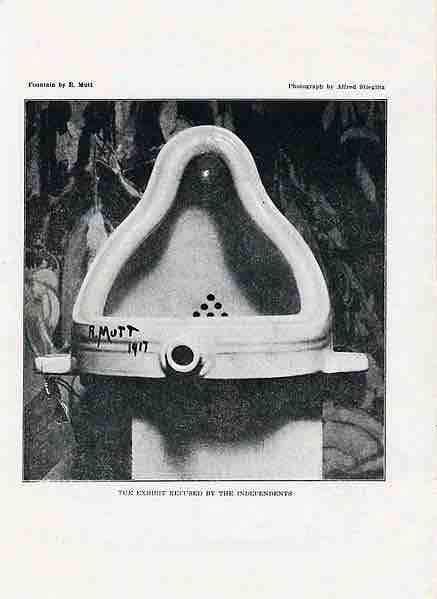Chance, improvisation, and spontaneity are elements that can be used to create art, or they can be the very purpose of the artwork itself. Any medium can employ these elements at any point within the artistic process.
Dadaism
Dadaism was an art movement popular in Europe in the early 20th century. It was started by artists and poets in Zurich, Switzerland with strong anti-war and left-leaning sentiments. The movement rejected logic and reason and instead prized irrationality, nonsense, and intuition. Marcel Duchamp was a dominant member of the Dadaist movement, known for exhibiting "ready-mades," which were objects that were purchased or found and then declared art.

Marcel Duchamp, Urinal, 1917
Marcel Duchamp's Urinal is an example of a "ready-made," which were objects that were purchased or found and then declared art.
Dadaists used what was readily available to create what was termed an "assemblage," using items such as photographs, trash, stickers, bus passes, and notes. The work of the Dadaists involved chance, improvisation, and spontaneity to create art. They are known for using "automatic writing" or stream of consciousness writing, which often took nonsensical forms, but allowed for the opportunity of potentially surprising juxtapositions and unconscious creativity.
Surrealism
The Surrealist movement, which developed out of Dadaism primarily as a political movement, featured an element of surprise, unexpected juxtaposition and the tapping of the unconscious mind. Andre Breton, an important member of the movement, wrote the Surrealist manifesto, defining it as follows:
"Surrealism, n. Pure psychic automatism, by which one proposes to express, either verbally, in writing, or by any other manner, the real functioning of thought. Dictation of thought in the absence of all control exercised by reason, outside of all aesthetic and moral preoccupation. "
Like Dadaism before it, the Surrealist movement stressed the unimportance of reason and planning and instead relied heavily upon chance and surprise as a tool to harness the creativity of the unconscious mind. Surrealists are known for having invented "exquisite corpse" drawing, an exercise where words and images are collaboratively assembled, one after another. Many Surrealist techniques, including exquisite corpse drawing, allowed for the playful creation of art through assigning value to spontaneous production.
The Fluxus movement
The Fluxus movement of the 1960s was highly influenced by Dadaism. Fluxus was an international network of artists that skillfully blended together many different disciplines, and whose work was characterized by the use of an extreme do-it-yourself (DIY) aesthetic and heavily intermedia artworks. In addition, Fluxus was known for its "happenings," which were multi-disciplinary performance events or situations that could take place anywhere. Audience participation was essential in a happening, and therefore relied on a great deal of surprise and improvisation. Key elements of happenings were often planned, but artists left room for improvisation, which eliminated the boundary between the artwork and the viewer, thus making the audience an important part of the art.